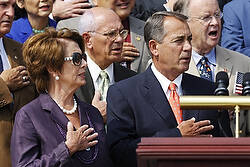The 2012 election sent the highest number of Catholics to each house of Congress since at least 1965. That’s one of the facts gleaned from Vital Statistics on Congress, a reference work that’s now free on the Internet, thanks to the Brookings Institution. You can download Vital Statistics either in PDF form or as Excel tables, allowing you to play with data on election returns, campaign finance and “productivity” in Congress.
According to Vital Statistics, 27 members of the U.S. Senate identified themselves as Catholic at the beginning of 2013, including 18 Democrats and nine Republicans. In the House, 136 representatives — including the Speaker, Republican John Boehner—identified as Catholic, making up 31 percent of the chamber’s total membership. (In 1965, the first year for which data are available, there were 14 Catholic senators and 94 Catholic representatives.)
While Catholic senators remain overwhelmingly Democratic, members of the lower chamber are more evenly divided. The Democrats have a 75-61 edge among Catholics in the House, but that’s far less lopsided than the 81-13 breakdown in 1965. Among Protestant members, the Republican Party has a 159-82 advantage.
Even as the Catholic caucus becomes more evenly divided by party (reflecting the closeness of the “Catholic vote” in presidential elections), it continues to have an outsized influence among Democrats. Last year, 37.5 percent of all Democrats in the House were Catholic, compared with 26.2 percent of Republicans and 31.4 percent of all members. One reason for the increasing visibility of Catholic Democrats is the party’s long, slow decline in the South, where evangelical Protestants have become a reliable voting bloc for the GOP. President John F. Kennedy would probably be pleased to learn that his party is no longer led by elderly Southerners in Congress—but not so pleased that his party is no longer in control of the House.
A few other highlights from Vital Statistics:
•All those years of candidates saying that government should be run more “like a business” may have had an effect. The number of U.S. representatives with a prior occupation in “business and banking” hit a low of 118 in 1977, which may have also been the high point of Ralph Naderism and the consumer movement. By 2009, a high of 225 representatives (or a slight majority of the House) had careers in business or banking. In 2013, that number was down to 187.
•A sizable majority (247) of U.S. representatives had a background in law in 1953, the earliest year for which data is available. By 2011, that number had fallen to 152, rebounding slightly to 156 two years later.
•In 2012, Democrats groused that 53.8 percent of the seats in the U.S. House went to Republicans, even though more people voted for Democratic candidates, by 48.5 percent to 47.8 percent. (Gerrymandering is not solely, or even primarily, to blame for this discrepancy, but that’s for another post.) But this may have been historical payback. Since World War II, the biggest differences between the popular vote and the distribution of House seats benefited the Democrats, who won 56.9 percent of the vote and 67.8 percent of the seats in 1964, and 56.2 percent of the vote and 67.1 percent of the seats in 1976. Barack Obama can only dream about what he’d do with the huge congressional majorities that were wrapped up in pretty bows and given to Lyndon Johnson and Jimmy Carter.








